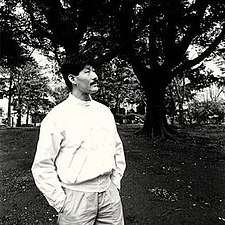Hiroshi Yoshimura
Hiroshi Yoshimura (吉村弘, Yoshimura Hiroshi, 22 October 1940 – 23 October 2003) was a Japanese musician and composer. He is considered a pioneer of ambient music in Japan.[1] Mostly the minimalist genre of kankyō ongaku, or environment music — soft electronic melodies infused with the sounds of nature; babbling brooks, steady rain, morning birds.[2]
Hiroshi Yoshimura | |
|---|---|
 | |
| Background information | |
| Birth name | Hiroshi Yoshimura (Japanese:吉村弘) |
| Born | October 22, 1940 Yokohama, Kanagawa Prefecture, Japan |
| Died | October 23, 2003 (aged 63) |
| Genres | |
| Occupation(s) |
|
| Instruments | Piano |
| Years active | 1972–2003 |
Early life
Hiroshi Yoshimura was born in Yokohama, Kanagawa in 1940. He graduated from Waseda School of Letters, Arts and Sciences II in 1964.
Career
He started the computer music group "Anonyme" in 1972. In 1978, he was commissioned by the NHK to compose the piece "Alma's Cloud".
In addition to solo performances and improvisational music, he performed production performance and sound objects, environmental music containing graphic design and sound design, visual poetry, and worked on sound design business in collaboration with TOA.[3] In addition to solo performance and improvisational music, he made music for galleries, museums, building spaces and train stations. He was at the forefront of environmental music.[4] He worked as a part-time lecturer in the Industrial Design Department at the Faculty of Engineering of the University of Chiba and at the Music Design Department of Kunitachi College of Music. He held workshops on citizen participation in museums.
Yoshimura died of skin cancer in 2003.
Legacy
In 2017, Yoshimura, as well as other ambient Japanese musicians, received a resurgence due to the YouTube algorithm.[5] In 2019, his song "Blink" off his debut album was selected for compilation album Kankyo Ongaku: Japanese Ambient, Environmental & New Age Music 1980-1990[6] In 2020, Light in the Attic Records released Green (The version without nature recordings) on Spotify, Youtube, Deezer, Apple Music, Google Play Music, Amazon music, (and much more) alongside CDs, vinyls and cassettes.[7]
His music has received much critical acclaim. In 2018, Crack Magazine selected his albums Green and Music For Nine Post Cards as the number 1 and number 7th most essential Japanese ambient albums respectively.[8] Malcolm Standing for Demo Magazine referred to Yoshimura as "one of the most influential and prolific of the artists to come out of Japan’s ambient renaissance".[9]
Discography
- Music For Nine Post Cards (1982)
- Pier & Loft (1983)
- A・I・R (Air In Resort) (1984)
- Green (1986)
- Soundscape 1: Surround (1986)
- 静けさの本 (Static) (1986)
- Flora (1987)
- Wet Land (1993)
- Face Music (1994)
- Quiet Forest (クワイエット・フォレスト) (1998)
- Four Post Cards (2004)
- Soft Wave For Automatic Music Box (2005) (His early work, published after death)
References
- "7 Essential Japanese Ambient and New Age Records". Crack Magazine. Retrieved 2018-06-05.
- "How YouTube resurrected Hiroshi Yoshimura's 'environment music' — and made me an accidental fan". 6 August 2019. Retrieved 20 December 2019.,
- "Hiroshi Yoshimura age, hometown, biography - Last.fm". Last.fm.
- "Hiroshi Yoshimura". Discogs.
- "How YouTube resurrected Hiroshi Yoshimura's 'environment music' — and made me an accidental fan". 6 August 2019. Retrieved 20 December 2019.,
- "Kankyō Ongaku: Japanese Ambient, Environmental & New Age Music 1980 1990". Retrieved 20 December 2019.
- Torres, Eric (March 20, 2020). "Light in the Attic Announces Reissue of Hiroshi Yoshimura's GREEN". Pitchfork. Retrieved April 10, 2020.
- "7 essential Japanese ambient and new age records". Retrieved 20 December 2019.
- "A Beginner's Guide To Ambient Music". Retrieved 4 May 2020.